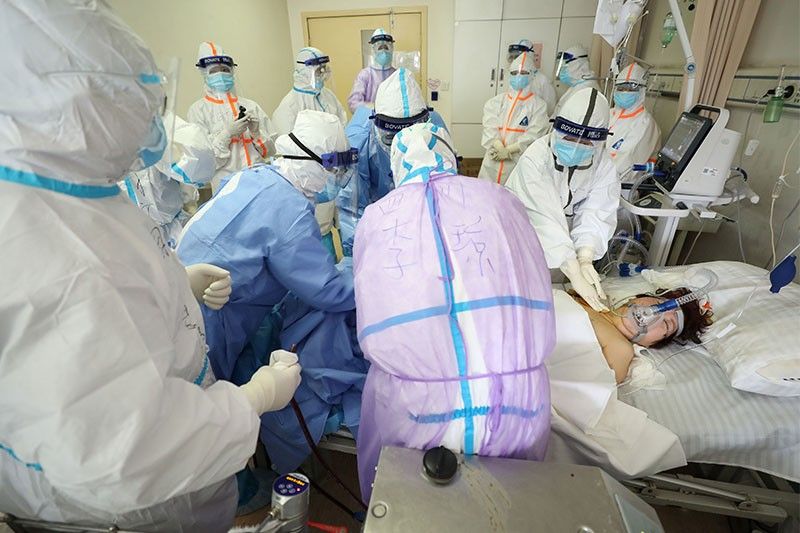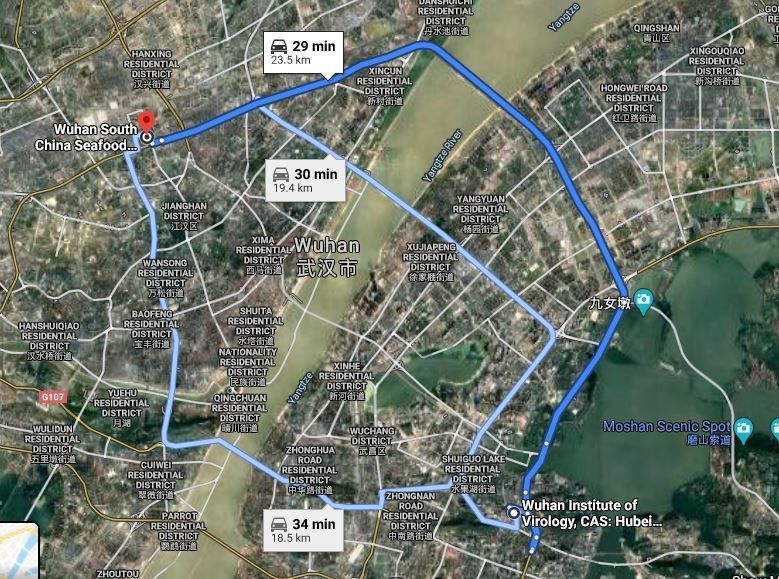Fact check: 'No clear evidence' for fringe theory virus was engineered in Wuhan lab

Existing evidence, theories on COVID-19 origins not conclusive, DOH says
MANILA, Philippines — It's been called "a story that won't go away."
True to its label, reports once again broke on local and international media networks throughout the week that the novel coronavirus disease 2019 (COVID-19) was actually engineered in a laboratory in the the pandemic's initial epicenter in Hubei province in China—a claim many have still been quick to believe.
Numerous media outlets promptly picked the story up: A report by Inquirer Lifestyle entitled "Research paper by Chinese scientists shows COVID-19 came from Wuhan biolab" extensively quotes a blog post by controversial China expert and writer Steven Mosher, who shared a February research paper linking COVID-19 to a biolab in Wuhan.
The paper, which was made available by Mosher on pro-life news outlet Life Site, was supposedly authored by two Chinese scientists from state-run South China University of Technology.
It has not been peer reviewed nor published in any academic journals as of this publication.
Despite this, Mosher wrote: "They concluded that the first case of a human having contracted the virus was probably a biolab worker from the WHCDC or WIV who accidentally exposed himself to blood or urine from a bat and infected himself. They also suggested that infected tissue samples from research animals, or the animals themselves, may have wound up in the wet market."
Since the onset of the virus, scientists worldwide have pinpointed the culprit as a bat coronavirus from a species identified as horseshoe bats, which scientists Botao Xiao and Lei Xiao in their paper said were not sold at the wet market in Wuhan.
'A story that won't go away'
Even in the United States, many public officials have repeated the fringe theories, from senators to US President Donald Trump himself. A report by Reuters quotes the president as saying that Beijing "needs to come clean."
RELATED: U.S. casts doubt on 'intentionally incomplete' Chinese coronavirus figures
Another report by Yahoo! News said that nine unnamed US intelligence officials with knowledge of China and national security were "still weighing the possibility that the pandemic might have been touched off by an accident at a research facility" although said that the intelligence community also "dismissed the notion that the coronavirus is a synthesized bioweapon."
And although Beijing's glowing releases on its alleged success in fighting the virus have been sketchy at best, both local and international experts alike have denied these theories, saying the new pathogen more than likely came about naturally rather than being a manipulated by humans.
Albeit in the middle of a resurgence of sorts, these theories are nothing new. As early as February, the Washington Post reported that US Senator Tom Cotton continued to trumpet the theory, which the Post tagged as "already debunked."
1. Natural (still the most likely, but almost certainly not from the Wuhan food market)
— Tom Cotton (@SenTomCotton) February 17, 2020
RELATED: Bioweapon conspiracy video creeps into Senate coronavirus hearing
'No clear evidence,' Philippine health department says
Sought for comment by Philstar.com, Health Secretary Francisco Duque III said, "That's a lot of speculation. I've heard about it but there is really no clear evidence to show that. There's not evidence unless it can be proven beyond reasonable doubt."
READ: Duterte can address COVID-19 without spreading China propaganda, De Lima says
"If there are pieces of evidence to prove it, then it's good. That means we have to study the issue more thoroughly and ask what the international community thinks about it," he added.
This sentiment is echoed in a similar report by the South China Morning Post, who quotes Vincent Racaniello, a professor of microbiology and immunology at Columbia University in New York as saying, “These accident theories – and the lab-made theories before them – reflect a lack of understanding of the genetic make-up of Sars-CoV-2 and its relationship to the bat virus."
Duque also admitted that the current narrative of the pathogen coming from the Wuhan South China Seafood Wholesale Market was not conclusive either.
"Even that is questionable eh. So there's nothing certain. They're saying it came from a seafood market or a wet market, and now that's being challenged," he said.
"They're saying that when the report came out that this was in December, right? But there seems to be a growing body of evidence that this might have occurred as early as November."
'Improbable conspiracy theory,' science says
A report published by nonprofit publication Science News tagged the theory as a "conspiracy theory" brought about by an "unfortunate coincidence that fueled conspiracy theorists."
Experts are generally agreed that the genetic properties of the virus shows beyond reasonable doubt that it was not engineered by humans in a laboratory.
Science News in its report quotes Tulane University virologist Robert Garry as saying the Wuhan Institute of Virology was “in very close proximity to” the Wuhan South China Seafood Wholesale Market, which "led people to think that, oh, it escaped and went down the sewers, or somebody walked out of their lab and went over to the market or something."
The Wuhan Institute of Virology is 15 miles (24 kilometres) away from the Wuhan South China Seafood Wholesale Market.
"Analysis from other researchers has since suggested that the virus probably jumped only once from an animal to a person and has been spread human to human since about mid-November," Science News said in its report.

In a study published March 17, 2020 in journal Nature Medicine entitled "The proximal origin of SARS-CoV-2," experts wrote, "It is improbable that SARS-CoV-2 emerged through laboratory manipulation of a related SARS-CoV-like coronavirus."
The study's authors, Kristian Andersen, Andrew Rambaut, W. Ian Lipkin, Edward Holmes and Robert Garry, agreed that analyses on the genome of SARS-CoV-2, the virus strain that causes COVID-19, clearly show that the new pathogen is not a laboratory construct.
"The genetic data irrefutably show that SARS-CoV-2 is not derived from any previously used virus backbone," the study went on, concluding that it is still possible that either horseshoe bats were still present at the wet market, or that "a progenitor of SARS-CoV-2 jumped into humans."
READ: Disrespect for animals caused COVID-19 pandemic — primatologist
"Although the evidence shows that SARS-CoV-2 is not a purposefully manipulated virus, it is currently impossible to prove or disprove the other theories of its origin."
Interestingly, Rosher also quotes a 2013 article also published by Nature.com co-authored by a WIV researcher in arguing that an unnamed Wuhan biolab was involved in collecting a SARS-like coronaviruses from horseshoe bats.
'Harmful to stir theories'
Responding to the early claims of biowarfare, Chinese Ambassador to the United States Cui Tiankai in an interview with CBS’s “Face the Nation” said, "It's true that a lot is still unknown."
“But it’s very harmful, it’s very dangerous, to stir up suspicion, rumors and spread them among the people. For one thing, this will create panic. Another thing is that it will fan up racial discrimination, xenophobia, all these things that will really harm our joint efforts to combat the virus,” he said.
While much is still unknown of the circumstances behind COVID-19's beginnings, one thing experts do agree on is that tracing the source of the outbreak would be vital in understanding how it spread and how to prevent the next potential pandemic.
"Either side is not conclusive yet, that's the best way of putting it," Duque said.
The Department of Health on Thursday afternoon recorded an additional 207 cases of COVID-19, driving the official tally to 5,660.
Around the world, the number of cases stands at 2,091,517, with 135,230 deaths and 516,831 recoveries. — with reports from Agence France-Presse
If you believe you have come into possible contact with infected patients, you may be directed to the proper office of the Department of Health for advice through the following lines: (632) 8651-7800 local 1149/1150 or (632) 165-364. You may also opt to call the Research Institute for Tropical Medicine at (02) 8807-2631/ 8807-2632/ 8807-2637. The general public has also been encouraged to forward its concerns to the Health Department's dedicated 24/7 COVID-19 hotlines (02) 894-COVID and 1555 (free for all subscribers).
- Latest
- Trending





























